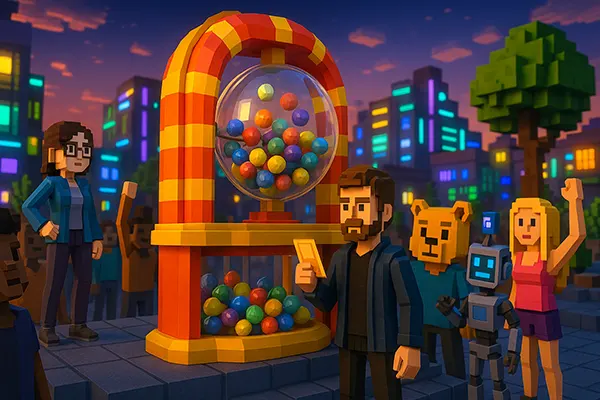
First Lotteries in the Metaverses: What We Know About NFT Draws in Decentraland and The Sandbox
As the concept of digital property continues evolving, metaverses are becoming more than just immersive environments — they’re forming the backdrop for new economic models. One such innovation is the rise of NFT lotteries, which are reshaping how users engage with virtual worlds like Decentraland and The Sandbox. In 2025, these initiatives are not only experimental entertainment but also tools for community growth, brand engagement, and technological innovation.
NFT Lotteries in Decentraland: How It All Started
Decentraland, built on the Ethereum blockchain, was among the first virtual ecosystems to test lottery mechanisms with non-fungible tokens. As early as 2021, community-led events began offering NFT items such as wearables, in-game art, and parcel tickets through prize draws. These lotteries became increasingly sophisticated over the years, evolving into gamified experiences integrated with branded partnerships and DAO-backed events.
In 2023 and 2024, major fashion houses and Web3 startups used Decentraland to launch campaigns featuring NFT raffles. These initiatives required users to complete quests, attend virtual shows, or participate in limited challenges, enhancing both brand visibility and user engagement. Players often had to hold specific tokens or complete verification steps, making the process more secure and interactive.
By mid-2025, Decentraland’s NFT lotteries are largely run through decentralised apps (dApps) that verify entries via smart contracts. Community trust remains critical, as transparency and on-chain records determine legitimacy. Verified prize pools, escrow systems, and third-party audits have become standard for credible events within the metaverse.
Benefits and Limitations of Decentraland’s Approach
One advantage of Decentraland’s system is the integration with established wallets and smart contracts, making participation straightforward for crypto-savvy users. The environment supports immersive events, allowing creators to layer storytelling and gameplay around each raffle. For instance, festivals now often end with NFT prize draws, rewarding long-term engagement.
However, access barriers remain. New users face onboarding challenges due to wallet setup and Ethereum gas fees. In addition, despite smart contracts ensuring fairness, technical hiccups or lack of oversight can lead to disputes — especially during high-demand events.
Nonetheless, Decentraland remains a key testing ground for how NFT lotteries can work within a functioning decentralised economy. Its pioneering events have informed other platforms and helped shape best practices across the space.
The Sandbox’s Vision for NFT Lotteries
The Sandbox, known for its voxel aesthetics and creator-centric economy, has taken a gamified approach to NFT-based lotteries. Here, prize draws are integrated directly into user-generated experiences, land parcels, and branded quests. Since late 2023, many creators have offered NFT rewards tied to competitions, mystery boxes, and event milestones.
Unlike traditional lotteries, draws in The Sandbox are typically earned through gameplay — for example, finishing a platformer level, solving puzzles, or exploring narrative-driven experiences. These interactions often serve dual purposes: boosting community retention and providing marketing exposure for creators and brands.
As of 2025, The Sandbox has also begun experimenting with licensed NFT drops connected to partner events. These include lotteries featuring limited-edition avatars, virtual real estate, and game assets. Prize validation is handled through smart contracts, and winnings are distributed via user wallets integrated into the platform’s backend systems.
Challenges with Scalability and Regulation
While engagement levels are high, scaling NFT lotteries across a fragmented user base has posed challenges. Game developers must balance fairness with fun, ensuring no exploitation occurs through bots or automation. This requires active moderation and frequent patching of vulnerabilities.
Another issue is regulatory ambiguity. Since some jurisdictions treat any lottery with financial value as a form of gambling, creators and hosts in The Sandbox must navigate legal grey areas. While decentralisation provides resilience, it doesn’t guarantee exemption from compliance requirements.
Despite these hurdles, the model remains attractive due to its low barrier to entry for players and integration into existing gameplay mechanics. The Sandbox’s blend of entertainment and economy helps draw in a wide range of participants, from casual users to seasoned collectors.

Current Trends and the Future of NFT Lotteries
By June 2025, NFT lotteries in metaverses are experiencing a shift towards curated, branded, and legally compliant events. With growing scrutiny on fairness and transparency, many organisers are opting for provably fair algorithms and decentralised governance. Players demand both trust and entertainment, which has led to hybrid models combining raffles with skill-based competitions.
There is also a rise in thematic draws, where NFT rewards represent entry tickets to virtual festivals, access to exclusive lands, or passes to elite DAOs. This transition adds long-term value beyond collectibles, embedding the lottery mechanism into broader metaverse utility ecosystems.
Cross-metaverse interoperability is another growing trend. Some platforms are exploring shared reward pools, where entries in one world (e.g. Decentraland) can yield prizes in another (e.g. The Sandbox). These cross-project initiatives aim to enhance collaboration and foster healthier user mobility between ecosystems.
What to Expect in the Coming Year
Looking ahead, expect tighter integration between NFT lotteries and virtual identity systems. Verification via soulbound tokens or reputation layers may replace wallet-based gating, improving user authenticity. This could reduce fraud and reward true engagement over brute force entry attempts.
Additionally, DAO governance over lottery mechanics is gaining traction. Communities now vote on prize types, eligibility criteria, and draw frequency, giving users more say in how these initiatives are structured. It marks a move toward more participatory, equitable systems.
In conclusion, while still evolving, NFT lotteries in metaverses like Decentraland and The Sandbox reflect the creative potential of blockchain-powered experiences. With careful innovation, these models could redefine how virtual economies reward participation and loyalty.
